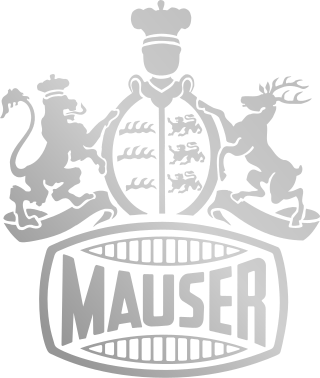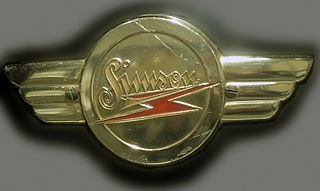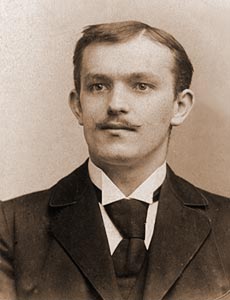
Thuringia, officially the Free State of Thuringia, is a state of central Germany, covering 16,171 square kilometres (6,244 sq mi), the sixth smallest of the sixteen German states. It has a population of about 2.1 million.

Ernst Friedrich Christoph "Fritz" Sauckel was a German Nazi politician, Gauleiter of Gau Thuringia from 1927 and the General Plenipotentiary for Labour Deployment (Arbeitseinsatz) from March 1942 until the end of the Second World War. Sauckel was among the 24 persons accused in the Nuremberg Trial of the Major War Criminals before the International Military Tribunal. He was found guilty of war crimes and crimes against humanity, sentenced to death, and executed by hanging.

Mauser, originally the Königlich Württembergische Gewehrfabrik, was a German arms manufacturer. Their line of bolt-action rifles and semi-automatic pistols was produced beginning in the 1870s for the German armed forces. In the late 19th and early 20th centuries, Mauser designs were also exported and licensed to many countries, which adopted them as military and civilian sporting firearms. The Gewehr 98 in particular was widely adopted and copied, and it is the foundation of many of today's sporting bolt-action rifles.

The Gewehr 43 or Karabiner 43 is a 7.92×57mm Mauser caliber semi-automatic rifle developed by Germany during World War II. The design was based on that of the earlier G41(W) but incorporated an improved short-stroke piston gas system similar to that of the Soviet SVT-40.

Suhl is a city in Thuringia, Germany, located SW of Erfurt, 110 kilometres NE of Würzburg and 130 kilometres N of Nuremberg. With its 37,000 inhabitants, it is the smallest of the six urban districts within Thuringia. Together with its northern neighbour-town Zella-Mehlis, Suhl forms the largest urban area in the Thuringian Forest with a population of 46,000. The region around Suhl is marked by up to 1,000-meter-high mountains, including Thuringia's highest peak, the Großer Beerberg, approximately 5 kilometres NE of the city centre.
Carl Walther GmbH Sportwaffen, or simply known as Walther, is a German firearm manufacturer, and a subsidiary of the PW Group. Founded by Carl Walther in 1886, the company has manufactured firearms and air guns at its facility in Germany for more than 100 years. Walther Arms, Inc. is the United States Walther business unit and is based in Fort Smith, Arkansas.

Hugo Schmeisser was a German developer of 20th century infantry weapons.

Friedrich Alexander Maria "Fritz" Mandl was chairman of Hirtenberger Patronen-Fabrik, a leading Austrian armaments firm founded by his father, Alexander Mandl.
Ludwig Loewe was a German merchant, manufacturer, philanthropist and a member of the Reichstag. Loewe's companies became involved in the production of armaments, employing famous designers and creating notable guns.

The Panzerbüchse 39, abbreviated PzB 39, was a German anti-tank rifle used in World War II. It was an improvement of the Panzerbüchse 38 rifle.

Simson was a German company which produced firearms, automobiles, bicycles and motorcycles, and mopeds. Under the Third Reich, the factory was taken from the Jewish Simson family, and was renamed several times under Nazi and later Communist control. The Simson name was reintroduced as a brand name for mopeds produced at the factory in the German Democratic Republic (GDR). Simson mopeds were then produced in Suhl (Germany) until 2002.
Otto Eberhardt Patronenfabrik was a munitions company established in 1860. The company's Hirtenberger Patronen, Zündhütchen und Metallwarenfabrik near Wiener Neustadt used forced labor during World War II from a sub-camp of the Mauthausen-Gusen concentration camp and produced ammunition including 9×19mm Parabellum and 8 mm Mauser (rifle) cartridges. The company also had a factory in Ronsdorf near Wuppertal which produced rifles. Additional Gustloff facilities were in Meiningen and Weimar.

J. P. Sauer und Sohn GmbH is a manufacturer of firearms and machinery and is the oldest firearms manufacturer still active in Germany. The products of this company are frequently referred to as Sauer.

The 8×50mmR Lebel rifle cartridge was the first smokeless powder cartridge to be made and adopted by any country. It was introduced by France in 1886. Formed by necking down the 11×59mmR Gras black powder cartridge, the smokeless 8mm Lebel cartridge started a revolution in military rifle ammunition. Standard 8mm Lebel military ammunition was also the first rifle ammunition to feature a spitzer boat tail bullet, which was adopted in 1898. The long-range ballistic performance of the 8mm Lebel bullet itself was exceptional for its time. For use in the magazine tube-fed early Lebel rifle, the 8 mm case was designed to protect against accidental percussion inside the tube magazine by a circular groove around the primer cup which caught the tip of the following pointed bullet. However, the shape of its rimmed bottle-necked case, having been designed for the Lebel rifle's tube magazine, also precluded truly efficient vertical stacking inside a vertical magazine. The bolt thrust of the 8mm Lebel is relatively high compared to many other service rounds used in the early 20th century. Although it was once revolutionary, the 8mm Lebel was declared obsolete after World War I and was soon after replaced with the 7.5×54mm French round.

The Landtag of Thuringia is the parliament of the German federal state of Thuringia. It convenes in Erfurt and currently consists of 90 members from seven parties. According to the free state's constitution, the primary functions of the Landtag are to pass laws, elect the Minister-President and control the government of Thuringia.

The Erfurter Maschinenfabrik (ERMA) was a German weapons manufacturer founded in 1922 by Berthold Geipel. Prior to and during World War II it manufactured many firearms, including the Karabiner 98k, the MP40 and other submachine guns.

Ziegenhahn & Sohn Jagdwaffen e.K. is a German arms manufacturing company. It was founded in 1911 and is located in Benshausen.
Nohra was the first of the early Nazi concentration camps in Germany, established 3 March 1933 in a school at an airfield in Nohra. The camp was administered by the interior ministry of Thuringia. The inmates were exclusively communists and included half of the Communist party group in the Thuringian state parliament. Prisoners were not forced to work or systematically abused, but had to suffer from poor hygienic conditions and did not have beds. The camp was closed down again after a few months, and the building was demolished in the 1950s. A plaque commemorating the camp was installed in 1988 but taken down in 1990; as of 2023 there is no memorial board for the camp.













